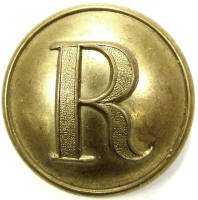
A virtual examination of artifacts of the American Civil War
by Harry Ridgeway
 |
Ridgeway Civil War Research Center, A virtual examination of artifacts of the American Civil War |
| Civil War Artillery | |
by Harry Ridgeway |
| Artillery projectile, stand of grape, canvass or "quilt" covered, iron balls, 32 pounder, 6.4in. The stand of grape was the artillerist's weapon of last resort. Once the enemy got close to the battery, the gunners would load these rounds, and the flimsy stand would burst on firing sending the contents in scatter fashion against the troops charging the cannon. The fire was devastating against the troops but the enemy would be so close that options to reload and shoot would have been limited. The quilted stand was an early design, the base and post were cast as a unit, three rows of four balls (12 total) were stacked around the post, then covered with canvass and twine, this early design did not have rings or a top. Based on the diameter of this projectile, it is believed that this could be used with any 6.4in. cannon, either 32 pounder smoothbore, or rifled 32 pounder. This pattern was developed well before the Civil War. However close fighting with these large guns seldom occurred, most of these projectiles were abandoned at the end of the war.. Projectile measures: diameter 6.1in., length 9in. (excluding fuze), weight 30lbs. Individual balls will measure 2.875in. approximately, the balls are often irregular. Research Center: Artillery2651-GrapeStand, Ref: Bell, Heavy Ordnance, pg. 99. Details click: http://relicman.com/artillery/Artillery2651-GrapeStand.html. |
| Ridgeway Civil War Research Center, A virtual examination of artifacts of the American Civil War. Artillery Research center, artillery, click: http://relicman.com/artillery/Artillery0000-Index.html. Research center, artillery, click: http://relicman.com/artillery/Artillery0000-Index.html. |
| Civil War Relicman, Harry Ridgeway, Civil War artillery, Relicman sales catalog. Click here: http://relicman.com/artillery/RelicmanSalesArtillery1.html. Artillery for sale: http://relicman.com/artillery/RelicmanSalesArtillery1.html. |